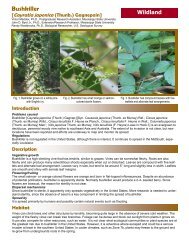RATopic1_95 - Geosystems Research Institute - Mississippi State ...
RATopic1_95 - Geosystems Research Institute - Mississippi State ...
RATopic1_95 - Geosystems Research Institute - Mississippi State ...
You also want an ePaper? Increase the reach of your titles
YUMPU automatically turns print PDFs into web optimized ePapers that Google loves.
Powe Pond: Aerial imagery was used to calculate the spread rate of water lettuce by analyzing imagery from May, June,<br />
and August 2008. Similar imagery was flown on September 19, 2008 prior to herbicide applications. On September 22,<br />
2008 the aquatic herbicide penoxsulam<br />
(Galleon tm ) was applied to the water column from<br />
a boat using a weighted hose system to obtain an<br />
herbicide concentration of 50 μg L -1 (ppb). Penoxsulam<br />
is a low use rate, slow acting systemic<br />
herbicide that inhibits branched chain amino acid<br />
production. Initial herbicide symptoms may take<br />
4-6 weeks to appear, however growth inhibition<br />
is rapid. Following the initial herbicide application,<br />
three water samples were collected from the<br />
pond and shipped to the SePRO <strong>Research</strong> and<br />
Technology Campus in Whitakers, NC for herbicide<br />
residue determinations. Water samples were<br />
collected at 3, 14, 17, and 30 days after treatment<br />
(DAT). The water samples documented the herbicide<br />
concentration in the pond, ensured adequate<br />
exposure of the plants to the herbicide, and<br />
allowed for monitoring the herbicide concentration<br />
over time to determine if supplemental applications<br />
were needed to maintain the desired herbicide concentration. Photographs were taken weekly for 9 weeks after<br />
Photo 1. Powe Pond in September 2008 prior to herbicide application.<br />
treatment (WAT) and then 1 year post treatment to document herbicide injury and overall control.<br />
Outflow Creek: The creek was surveyed to identify how far the plants had moved from the pond and to apply the aquatic<br />
herbicide imazamox (Clearcast tm ) to plants growing in<br />
Table 1. Mean herbicide concentrations in Powe Pond following<br />
the creek. Imazamox was applied as a foliar application<br />
using a 3% by volume concentration. The surfac-<br />
herbicide applications.<br />
tant DyneAmic tm Herbicide (ppb) 3 DAT 14 DAT a 17 DAT b 30 DAT<br />
was added to the spray solution at 1%<br />
v:v. Additional surveys were conducted in October<br />
Penoxsulam 50.03 38.7 26.2 66.1<br />
2008, May 2009, and September 2009 to ensure herbicide<br />
efficacy and water lettuce eradication in the creek.<br />
b Applied a follow up application on Oct. 20, 2008 of 30 ppb of<br />
a Heavy rain following this sample date<br />
penoxsulam to maintain 50 ppb concentration in the pond<br />
Results and Discussion<br />
Photo 2. Chlorosis of water lettuce tissue following<br />
exposure to the herbicide penoxsulam.<br />
day -1 from June 2008 to September 2008.<br />
Water lettuce Introduction and Growth: Historic aerial imagery indicates<br />
that there was no water lettuce in Powe Pond in August 2007<br />
(Figure 1). Using similar imagery, it was observed that water lettuce<br />
may have been introduced into the pond in June 2008 where it infested<br />
approximately 0.02 acres (Figure 2). However, by August 2008 water<br />
lettuce occupied large<br />
areas of the pond and by<br />
September 2008 the entire<br />
pond surface was<br />
covered by water lettuce,<br />
and subsequently reported<br />
to the <strong>Geosystems</strong><br />
<strong>Research</strong> <strong>Institute</strong><br />
(Figures 3 and 4; Photo<br />
1). The water lettuce<br />
infestation expanded<br />
approximately 0.03 acres<br />
Photo 3. Herbicide injury 2 WAT showing the<br />
deterioration of the outer leaves and chlorosis<br />
beginning in the center of the rosette.<br />
2009 USGS Annual Report 16 <strong>Mississippi</strong> <strong>State</strong> University’s <strong>Geosystems</strong> <strong>Research</strong> <strong>Institute</strong>




